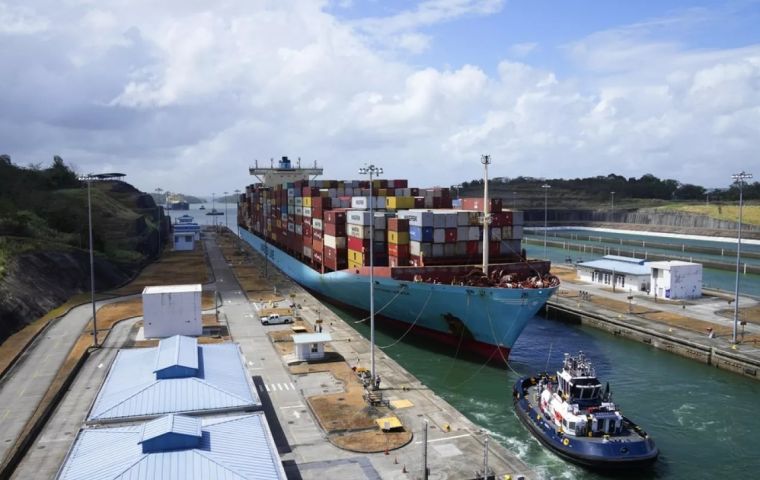MercoPress. South Atlantic News Agency
Panama Canal restrictions expected to last for at least ten months; large containers to reroute to Suez Canal
 Panama Canal have cut draft restrictions for ships transiting neo-panamax locks by 2 m as well as slashing the volume of daily transits by 20% to 32 vessels a day
Panama Canal have cut draft restrictions for ships transiting neo-panamax locks by 2 m as well as slashing the volume of daily transits by 20% to 32 vessels a day Global shipping has been urged to share transit plans at one of the world’s key maritime crossings following on Panama Canal Authority officials warning that water-conserving restrictions will be in place for at least the next 10 months, given this year's unprecedented drought which Panama is experiencing.
As a consequence of the drought and the onset of the El Niño weather phenomenon, administrators at the Panama Canal have cut the draft restrictions for ships transiting its larger neo-panamax locks by 2 m as well as slashing the volume of daily transits by 20% to just 32 vessels a day. These measures have seen ships queuing up in significant numbers at both ends of the canal. The official count of ships waiting to cross on Monday midday was 129, down from the peak of 165 earlier this month, but still 43% higher than the average.
The canal’s deputy administrator, Ilya Espino, said on Sunday the restrictions would remain in place for at least the next 10 months, throughout the first half of next year.
Container services and cruise itineraries tend to transit the canal with long advanced bookings. For bulk sectors, it is more ad hoc and with shorter notice, and it is has been here that the impact has been greater this month, where it might not be possible to obtain an advanced booking and therefore joining the queue is necessary.
For containerships, which will likely continue to have draft restrictions that means that around 2,500 teu of space cannot be utilized and therefore a maximum head-haul utilization of 84%. For those 12,000 teu+ ships, re-routing via Suez would be one option that many liners will now be looking at given the official line from Panama that the restrictions are here to stay.
For smaller containerships, which can still pass fully laden, a backhaul return to Asia via the Suez or the Cape with a slightly longer distance and time is another option liners will be looking at to reduce overall Panama demand while also soaking up capacity at a time, where container fortunes are widely perceived to be on the wane through to at least the end of next year.
There has already been one cruise ship which has cancelled its winter Panama season. Container carriers switching routes will be watched carefully by other sectors keen to get prized slots through the waterway in the coming months.
“Maybe the bulk and container segments such as the World Shipping Council, INTERTANKO, INTERCARGO and BIMCO along with the Panama Canal Authority can come together to strategically plan how to best use the limited resources in the short and medium term. Such cross-industry coordination and collaboration, I think would be a first,” suggested Andy Lane, a partner at shipping advisory CTI Consultancy.
The difficulties at the canal are not having a notable lifting effect on container spot rates in the past fortnight. Drewry’s weekly World Container Index, published last week, showed rates from Shanghai to New York were down by $120 per feu.




Top Comments
Disclaimer & comment rulesCommenting for this story is now closed.
If you have a Facebook account, become a fan and comment on our Facebook Page!